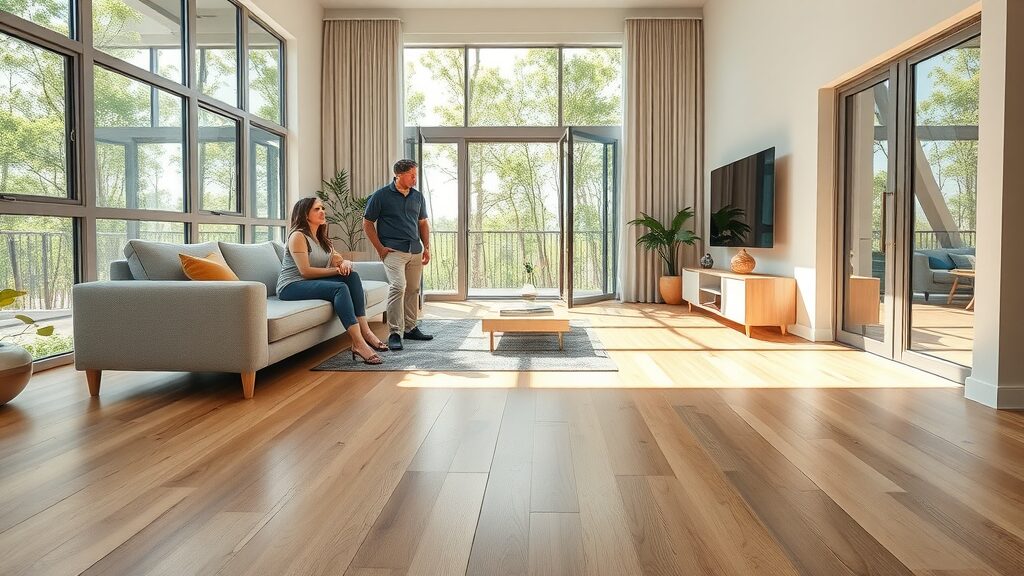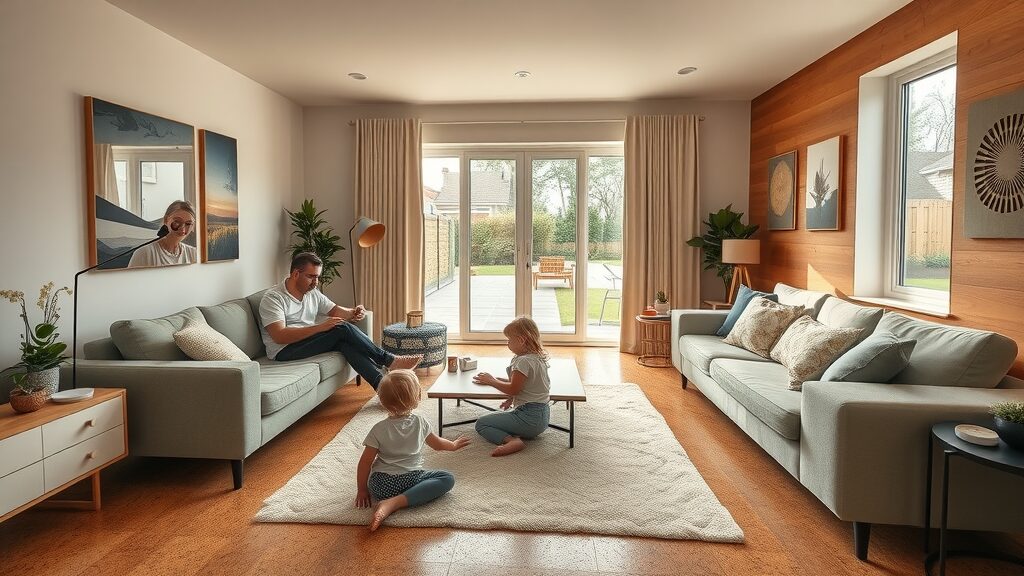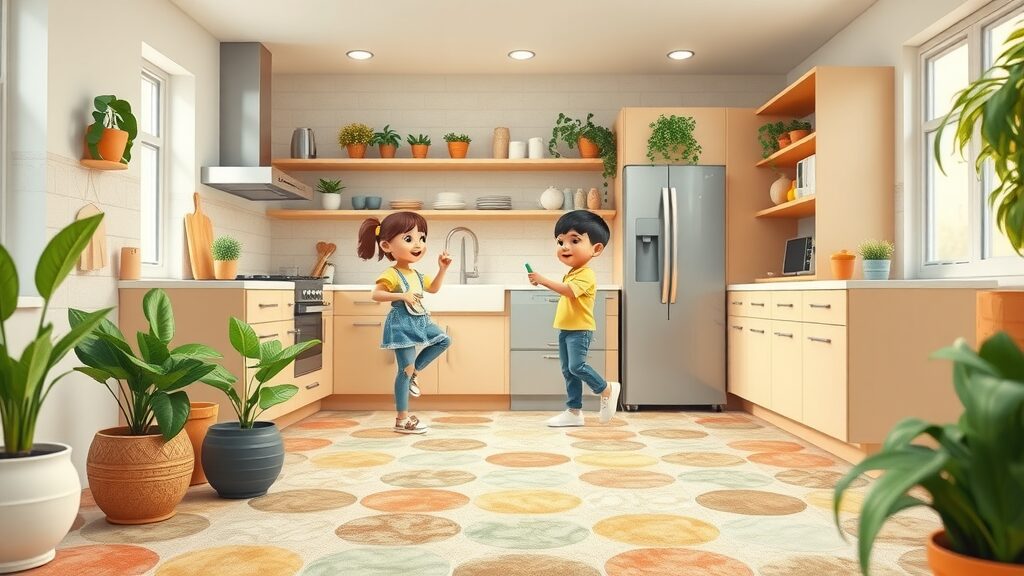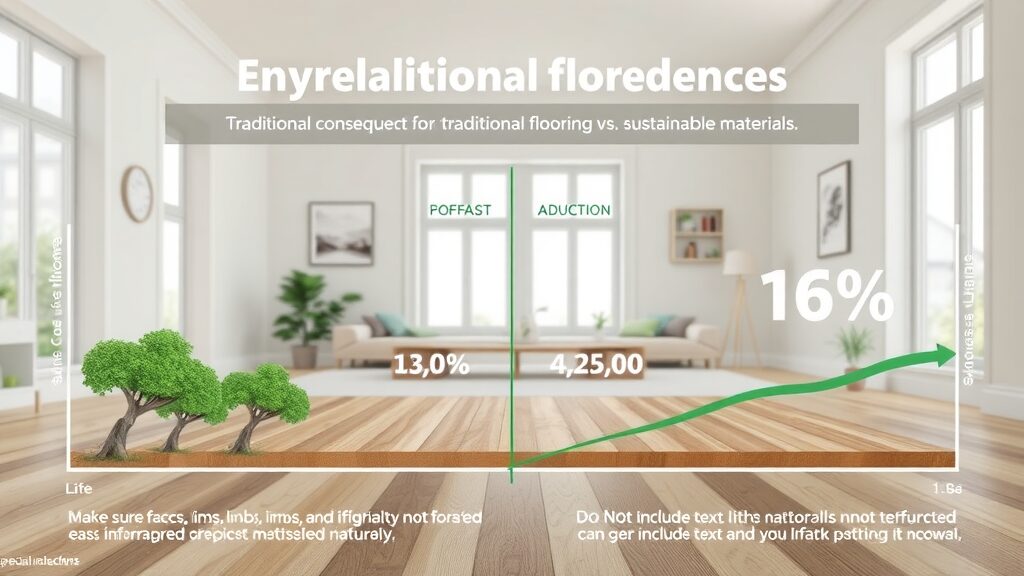Did you know over 3 billion square feet of traditional flooring are installed each year, much of it contributing to deforestation and landfill waste? The urgency for sustainable flooring options is more than a passing trend; it’s a critical strategy to preserve our planet and enhance the health of modern homes. This comprehensive guide will walk you through the best eco-friendly flooring options—explaining their impact, comparing costs, and showing you how easy it is to make a change that pays off in both style and conscience.
Shocking Stats: How Choosing Sustainable Flooring Options Impacts Our Planet
- Each year, traditional flooring production accounts for 3 million tons of landfill waste in the U.S. alone.
- Many conventional flooring materials contain volatile organic compounds (VOCs) , which pollute indoor air and worsen respiratory conditions.
- Switching to green flooring options such as bamboo or cork can lower a home’s carbon footprint by up to 30%, thanks to renewable harvesting methods and low-emission manufacturing.
- Recycled-content flooring options save thousands of tons of post-consumer glass, rubber, or plastic from ending up in landfills each year.

Why Sustainable Flooring Options Matter for Modern Living
- Consumer demand for eco-conscious flooring materials has surged in the past five years, driven by a desire for healthier living spaces and environmental responsibility.
- Sustainable flooring improves indoor air quality, helping families avoid exposure to harsh chemicals found in many traditional floors.
- A wide range of green floor products now meet the needs of allergy-sensitive households and support healthier lifestyles.
“More than 60% of homeowners are now considering eco-friendly flooring options, up from just 25% in 2017.”
As hybrid work and remote living increase, homes have transformed into multi-use sanctuaries—making the choice of flooring material even more crucial. Sustainable options are no longer niche; they’re a standard for anyone seeking a balance of wellness, style, and long-term value in their flooring project.
Eco-Friendly Flooring Options: Paths to Sustainability and Style
Overview of flooring options that meet sustainability standards
There are several sustainable flooring options available that blend durability with eco-friendliness. Whether you’re renovating a modern loft or building a classic family home, sustainable flooring now encompasses a wide range of looks and applications. Popular green floor choices include bamboo flooring , cork flooring , reclaimed hardwood floor , natural linoleum , and a variety of innovative recycled tile and rubber products. Each flooring option supports different aesthetic tastes while reducing harmful impacts on forests and landfills.
- Bamboo Flooring : Rapidly renewable, stylish, and suitable for high-traffic spaces.
- Cork Flooring : Harvested from the bark of the cork oak tree, providing comfort, insulation, and sound dampening.
- Reclaimed Hardwood Floor : Salvaged wood gives a new life to planks that would otherwise be burned or wasted.
- Natural Linoleum : Made from linseed oil, wood flour, and jute, perfect for allergy-prone environments.
- Recycled Tile & Rubber : Transforms post-consumer glass, plastic, and rubber into functional, eye-catching floors.
| Material | Renewability | Durability | Cost | Maintenance |
|---|---|---|---|---|
| Bamboo | High (matures in 3-5 years) | Very durable | $$ | Easy (sweep & mop) |
| Cork | High (harvested every 9 years) | Medium-High | $$$ | Moderate (reseal occasionally) |
| Reclaimed Hardwood | Medium (repurposed wood) | Very durable | $$$$ | Refinish as needed |
| Natural Linoleum | High (made from natural material) | High | $$ | Easy (wipe clean) |
| Recycled Tile/Rubber | High (made from recycled materials) | Medium-High | $$$ | Low (very low maintenance) |
Best Bamboo Flooring: A Fast-Growing Favorite Among Sustainable Flooring Options
Why bamboo flooring is a top sustainable flooring material
- Renewable Material : Bamboo grows back after harvesting, reaching maturity within 3–5 years, making it far more sustainable than traditional oak or maple wood floors.
- Appearance : Modern bamboo flooring is available in wide range of shades and grain patterns, fitting both contemporary and classic interiors.
- Durability : Strand-woven bamboo is as strong as (or sometimes tougher than) hardwood flooring, standing up to heavy use and pets.
- Maintenance : Simply sweep and mop with a damp cloth; occasional refinishing restores shine, making it a low-fuss sustainable choice.
 The popularity of bamboo flooring is rooted in its exceptional balance between style, toughness, and environmental stewardship. As a highly renewable resource, bamboo helps reduce pressure on forests and provides a sleek alternative to conventional wood flooring options. The natural warmth of bamboo planks invites both comfort and sophistication into any home seeking a sustainable option for floors.
The popularity of bamboo flooring is rooted in its exceptional balance between style, toughness, and environmental stewardship. As a highly renewable resource, bamboo helps reduce pressure on forests and provides a sleek alternative to conventional wood flooring options. The natural warmth of bamboo planks invites both comfort and sophistication into any home seeking a sustainable option for floors.
Cork Flooring: Resilient and Renewable Sustainable Option
Advantages of cork flooring for green flooring projects
- Comfort & Cushioning : Cork is harvested from the bark of the cork oak tree, providing a springy feel and natural give, reducing fatigue for standing or playing households.
- Insulation & Acoustics : Cork’s cellular structure offers excellent temperature insulation and acoustic dampening, making it ideal for bedrooms, home offices, and media rooms.
- Recyclability : Made from sustainable cork oak forests, cork flooring can be easily recycled or upcycled after its useful life.
 Cork flooring has emerged as a green floor favorite. It’s harvested without harming the cork oak tree, supporting managed forests and local ecosystems. In addition to being a renewable and recyclable flooring material , cork floors feel gentle on joints, buffer household noise, and help families maintain comfortable indoor temperatures throughout the year. This makes cork a versatile, allergy-friendly sustainable flooring option well-suited for family living.
Cork flooring has emerged as a green floor favorite. It’s harvested without harming the cork oak tree, supporting managed forests and local ecosystems. In addition to being a renewable and recyclable flooring material , cork floors feel gentle on joints, buffer household noise, and help families maintain comfortable indoor temperatures throughout the year. This makes cork a versatile, allergy-friendly sustainable flooring option well-suited for family living.
Hardwood Flooring: How to Source Truly Sustainable Wood Floors
Certification and responsible sourcing of hardwood flooring
- Look for FSC-certified or Forest Stewardship Council labels to ensure your wood flooring comes from responsibly managed forests.
- Choose flooring options made with non-toxic adhesives and finishes to reduce volatile organic compounds in your home.
- Confirm that the manufacturer uses sustainable harvesting and replanting practices for lasting environmental impact.
When considering new hardwood flooring , responsible sourcing is essential. Certifications like the Forest Stewardship Council guarantee wood floors originate from forests that maintain biodiversity, regenerate naturally, and support local communities. Homeowners can also seek reclaimed hardwood or products made from rapidly renewable wood species, further reducing pressure on endangered habitats. Selecting sustainably sourced hardwood floor promotes transparency and eco-accountability in any flooring project.
Natural Linoleum: Surprising Benefits in Sustainable Flooring Material
- Comprised mainly of linseed oil (from flax plants), natural linoleum is fully biodegradable and contains zero petrochemicals.
- Boasts impressive resistance to wear, dents, and scratches, making it a favorite for kitchens, mudrooms, and play spaces.
- Comes in an array of vibrant colors and patterns, perfect for creative spaces and design-forward environments.
- Low-maintenance and naturally antimicrobial—an excellent green floor for allergy- and asthma-prone households.
 Despite its vintage reputation, natural linoleum has made a stylish comeback as an eco-friendly floor. It’s composed of rapidly renewable ingredients—including wood flour, cork dust, and jute—making it a top sustainable flooring material . From creative kitchens to energetic playrooms, natural linoleum’s resilience, variety, and safety deliver benefits hard to match with synthetic products.
Despite its vintage reputation, natural linoleum has made a stylish comeback as an eco-friendly floor. It’s composed of rapidly renewable ingredients—including wood flour, cork dust, and jute—making it a top sustainable flooring material . From creative kitchens to energetic playrooms, natural linoleum’s resilience, variety, and safety deliver benefits hard to match with synthetic products.
Recycled Flooring Options: Tiles, Carpet, and Rubber for True Circular Design
How recycled glass, plastic, and rubber floor products transform waste into style
- Recycled Glass Tile : Shimmering mosaics made from post-consumer bottles offer a unique, high-impact look.
- Recycled PET Carpets : Durable carpets created from used plastic water bottles keep millions of pounds of plastic out of landfills.
- Recycled Rubber : Tough, forgiving, and perfect for home gyms or playrooms; made from old tires and sporting shoes.
 The latest recycled flooring options allow you to create show-stopping interiors that champion circular design. Whether you want expressive mosaic floors for creative spaces or resilient surfaces for active households, recycled-content flooring provides beauty and peace of mind. Each choice contributes to fewer resources extracted, less energy consumed, and a meaningful reduction in landfill waste.
The latest recycled flooring options allow you to create show-stopping interiors that champion circular design. Whether you want expressive mosaic floors for creative spaces or resilient surfaces for active households, recycled-content flooring provides beauty and peace of mind. Each choice contributes to fewer resources extracted, less energy consumed, and a meaningful reduction in landfill waste.
What Makes Flooring Material Truly Green?
- Look for third-party certifications such as LEED , Greenguard , and FloorScore to ensure products meet strict environmental and health guidelines.
- Read eco-labels closely: they reveal renewable content, emission levels, and recyclability.
- Opt for flooring material manufactured using renewable energy and minimal chemicals.
“Choosing sustainable flooring means supporting cleaner air, healthier homes, and a safer future for our children.”
True sustainable flooring is defined by more than just recycled or renewable material. It involves the full product lifecycle—from how raw materials are harvested, to indoor air emissions, to end-of-life recyclability. Ethical manufacturing, transparency in the supply chain, and trusted certifications ensure your new green floor is a genuinely sustainable choice, not just a marketing catchphrase.
Aesthetic Versatility: Sustainable Flooring Options for Every Interior Design
- Eco-friendly floors are now crafted in virtually every color, plank size, texture, and pattern, suitable for rustic, industrial, or minimalist spaces alike.
- Many flooring material options—like cork, bamboo, and recycled tile—are available in custom finishes, allowing you to curate a personal look.
- Sustainable flooring options pair beautifully with natural materials in furnishings, enhancing an organic, cohesive style throughout your home.
Designers and homeowners agree: sustainable flooring options offer a level of versatility and creativity previously lacking in green floor products. Whether your taste leans boho, modern, or traditional, there’s a flooring option out there to enhance your vision, all while supporting planetary health.
Cost vs. Value: Are Sustainable Flooring Options Really Affordable?
- Although certain sustainable flooring options come with higher initial costs, they generally offer greater longevity and lower lifetime expenses than many conventional flooring materials .
- Green floors can increase home resale value due to growing eco-conscious consumer demand.
- Many options—like bamboo and cork flooring—require less frequent replacement, reducing total investment over decades.
| Flooring Option | Upfront Cost (per sq. ft.) | Expected Lifetime (years) | Maintenance Cost | Resale Value Impact |
|---|---|---|---|---|
| Bamboo Flooring | $5-8 | 20-30 | Low | High |
| Cork Flooring | $6-10 | 25+ | Low-Moderate | Medium-High |
| Natural Linoleum | $5-7 | 40+ | Low | Medium |
| Recycled Tile | $8-15 | 50+ | Very Low | High |
| Reclaimed Hardwood Floor | $10-20 | 50+ | Variable | Very High |
Savvy homeowners recognize that the slight premium paid for sustainable flooring pays off through fewer replacements, less health risk, and the ability to command higher offers at resale—making these green flooring options a practical financial decision as well as an ethical one.
Installation and Maintenance Tips for Your Sustainable Flooring Options
- Assess your project: Consider subfloor type, humidity, usage, and aesthetic before choosing a flooring option .
- Consult professionals or use easy click-lock systems for DIY-friendly green floor installations.
- Choose low-VOC adhesives and underlayments made from recycled materials to limit environmental impact during floor installation.
Easy cleaning and care guidance for each green floor material
- Bamboo: Sweep regularly, mop with a lightly dampened cloth, and avoid excess moisture.
- Cork: Clean with gentle pH-neutral soaps, reseal every few years to prevent moisture damage.
- Linoleum: Use mild soap and water; avoid harsh chemicals and ammonia-based cleaners.
- Recycled Tile & Rubber: Vacuum or damp mop as needed; these require minimal ongoing care.
Whether you’re working with bamboo, cork flooring, or another sustainable flooring option , maintaining your investment is easy with the right products and techniques. Look for cleaning supplies labeled as non-toxic, biodegradable, and safe for children and pets to ensure your green floor remains a healthy surface for years to come.
Green Flooring Innovations: Emerging Trends in Sustainable Flooring
- Use of low-emission adhesives for safer installations and prolonged indoor air quality.
- Digitally printed tiles mimic exotic stone or rare hardwood while using far fewer resources.
- Recycled-content underlayments add comfort and efficiency to every flooring project .
- Smart home integrations allow for temperature and moisture monitoring, extending the lifespan of your sustainable flooring options .
As technology evolves, so do the possibilities for green flooring . Homeowners can now enjoy high-style surfaces with intelligent features, all while supporting a more sustainable, circular economy in flooring material production.
Watch our expert video guide to see the latest installation tips, discover the top sustainable flooring material for each room, and learn how real homeowners are living beautifully and responsibly with green floor solutions.
Choosing Sustainable Flooring Options: Step-by-Step Guide
- Identify the room’s needs: durability, moisture resistance, comfort, and style preferences.
- Set a realistic budget for initial purchase and professional installation if needed.
- Research sustainably certified products—look for LEED, Greenguard, FSC, or FloorScore labels.
- Compare material pros and cons (see tables above) to narrow your selection.
- Consider maintenance and long-term care requirements for each flooring option .
- Request samples and consult with eco-conscious flooring experts before placing your order.
Making informed choices about sustainable flooring options doesn’t have to be overwhelming. This checklist simplifies the process, ensuring that every project contributes to a healthier home and planet without sacrificing comfort or design.
People Also Ask: Sustainable Flooring Questions Answered
What is the least toxic type of flooring?
- Solid hardwood flooring, natural linoleum, and cork are considered the least toxic flooring options when verified by independent certifications such as Greenguard and FloorScore.
- These materials contain minimal volatile organic compounds and are finished with natural oils or water-based sealers, reducing chemical exposure in the home.
What is the ideal flooring for their environment?
- For humid climates, bamboo flooring resists swelling and shrinking better than many hardwood floor species.
- Cork flooring is great for homes needing sound absorption and warmth.
- For allergy-prone families or kitchens, natural linoleum provides a hypoallergenic, easy-to-clean surface.
What is the best flooring for energy efficiency?
- Cork delivers top-notch insulation, maintaining consistent indoor temperatures and cutting heating costs.
- Carpets made from recycled PET also provide warmth and efficiency in colder rooms.
- Paired with dual-paned underlays, wood flooring options retain heat very efficiently.
What is the best no maintenance flooring?
- Engineered bamboo flooring , sealed linoleum , and recycled tile are the most durable and low-maintenance sustainable flooring options, requiring only occasional sweeping and minimal upkeep.
FAQ: Practical Insights Into Sustainable Flooring Options
- How long does sustainable flooring last? Quality green floor products, like bamboo, cork, and natural linoleum, can last 20-50 years or more with proper care—sometimes longer than standard carpet or laminate.
- Are sustainable floors good for pets? Bamboo and recycled rubber floors are especially pet-friendly, resisting scratches and stains while offering easy cleaning.
- How resistant are these floors to allergies? Most sustainable flooring material options are naturally hypoallergenic, and they don’t harbor dust mites or mold, unlike wall-to-wall carpet made from synthetic fibers.
- Are green flooring options difficult to install? Many products incorporate click-and-lock designs, but if not, certified eco-friendly installation experts can ensure a hassle-free experience with appropriate adhesives and underlays.
Success Stories: Homeowners Who Chose Sustainable Flooring Options
- After upgrading their home with cork flooring, a young family from St. Louis reported, “The kids’ allergies disappeared, and the entire house feels quieter and warmer.”
- One recent remodel using recycled glass tiles resulted in a bathroom that “sparkles in the sunlight and feels truly unique—guests are always amazed it came from old bottles!”
-
“Upgrading to cork flooring slashed our heating bill by 20% last winter and our toddler loves rolling around on the soft, natural floor.”
Real-life experiences demonstrate that sustainable flooring options not only boost home comfort and style but can also yield health and financial rewards that keep growing year after year.
Key Takeaways for Selecting Sustainable Flooring Options
- Choose products with respected green certifications, such as FSC, Greenguard, or LEED.
- Match your family’s needs—consider allergies, pets, durability, and climate when selecting a green floor.
- Explore both natural and recycled materials for maximum sustainability and design flexibility.
- Investing in sustainable flooring options can save money over time, increase home value, and create a healthy, beautiful living environment.
- Consult local experts to ensure proper installation and ongoing eco-friendly maintenance.
Take Action for a Healthier Home and Planet
- Get quality flooring and 5-star service—call HomeTown Floors today at (636) 244-4951 or book online at www.hometownfloorsonline.com !
Exploring sustainable flooring options can significantly enhance your home’s eco-friendliness and aesthetic appeal. For a comprehensive overview, consider reading “It Starts From the Ground Up – 9 of the Most Eco-Friendly Flooring Options That Still Have Plenty of Style” . This article delves into various materials like bamboo, cork, and reclaimed wood, highlighting their environmental benefits and design versatility. Additionally, “Turns Out There’s Way More to Love About Cork Flooring Than Just Good Looks” offers an in-depth look at cork flooring, emphasizing its sustainability, comfort, and unique aesthetic qualities. If you’re serious about making environmentally conscious choices for your home, these resources will provide valuable insights into stylish and sustainable flooring solutions.


Leave a Reply